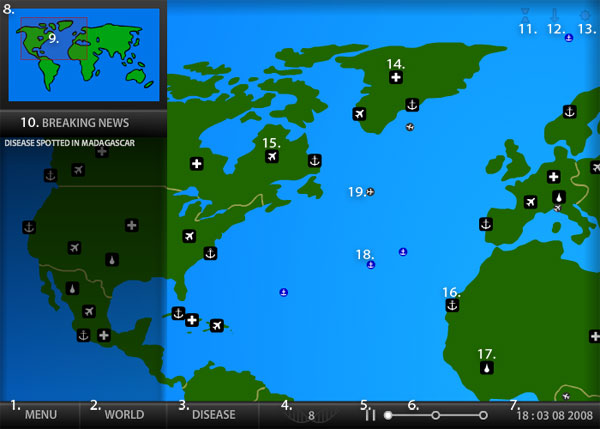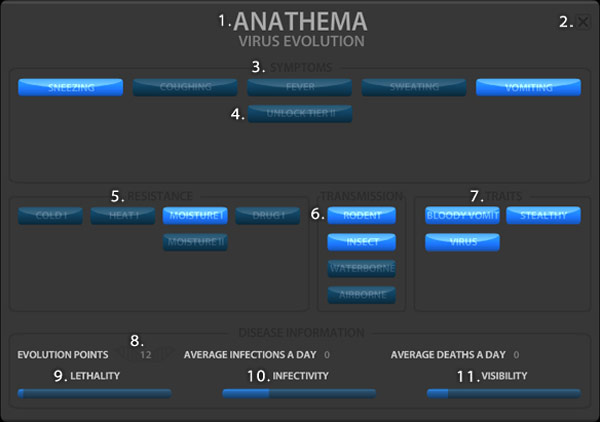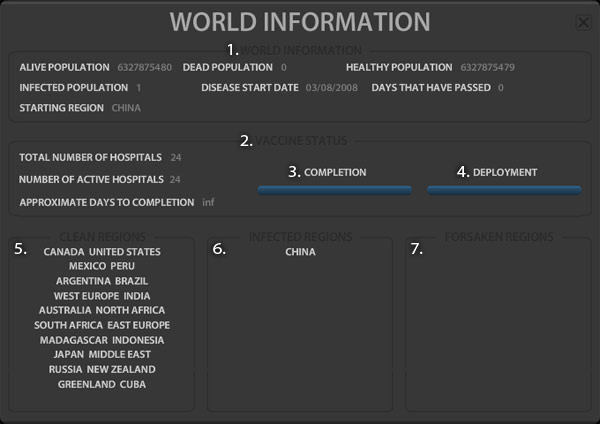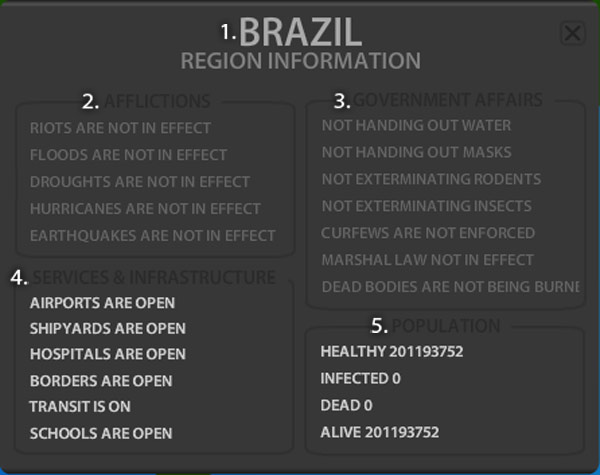1.
Menu button that allows you to save, toggle music on or off, start a new game, check the Pandemic 2 guide or watch the tutorial video.
2.
Brings up the world screen.
3.
Brings up the virus evolution screen.
4.
The number of evolution points you currently have.
5.
The pause and play button.
6.
The game speed controller.
7.
The game clock.
8.
The minimap.
9.
The viewport positioner.
10.
The news panel.
11.
Notification that indicates a natural disaster has occurred.
12.
Notification that indicates a new region has been infected.
13.
Notification that indicates a new trait has been awarded.
14.
A hospital.
15.
An airport.
16.
A shipyard.
17.
A water plant. Infected water plants are red instead of white.
18.
A boat.
19.
A plane.
General Information
With the minimap, you can easily navigate the entire globe, centering the viewport over your desired regions of interest.
How To Use
To use the minimap, place the mouse over the red rectangle with in the minimap. Click and drag the minimap with the left mouse button to the place you want to see. Let go of the left mouse button once you are at your destination.
General Information
The clock displays the current date, as well as the current time. In the image, "21:" would be the hour of the day. ":03" would be the current day. ":08" would be the current month. And the remaining section is the current year.
General Information
Occasionally during a game, prompts may pop up to tell you something. Usually this information is fairly important, so take your time when reading one. Once done with a prompt simply click the "X" in the top right hand corner to close it.
1.
The name of your disease.
2.
The exit button.
3.
Symptoms available to be purchased or sold.
4.
Unlock button, that allows you to gain access to next level of symptoms.
5.
Available resistances.
6.
Available transmissions.
7.
Traits that have been awarded.
8.
Number of evolution points.
9.
How lethal your disease is.
10.
How infectious your disease is.
11.
How visible your disease is.
1.
General world information.
2.
Information about vaccines.
3.
Vaccine development.
4.
Vaccine deployment.
5.
Regions that are not infected.
6.
Regions that are infected.
7.
Regions that are devoid of any human life.
1.
The name of the current region that is selected.
2.
Any current afflictions that are in affect.
3.
Any current government activity.
4.
The status of region services and infastructure.
5.
Information about the region population.
Realistic
While playing in realistic mode, you are able to save the progress of your disease. Games take longer to play since it takes longer to accumulate evolution points. Governments react more intelligently, and it is more difficult for your disease to spread effectively. This mode is recommended for intermediate or expert players.
Relaxed
While playing in relaxed mode, you are unable to save the progress of your disease. This is due to the fact that most games should not last longer than 20 minutes. Governments react slower, making it easier to spread your disease. Some game events will not appear during relaxed play. This mode is recommended for beginner players.
Objectives
The objectives of Pandemic 2 are simple. Evolve your disease intelligently, Spread your disease to everyone, Kill everyone. You are going to want governments as relaxed as possible, to avoid causing a panic. So make sure to keep the visibility of your virus as low as possible. Even if visibility is low, governments are still going to panic if people suddenly start dying everywhere. Pay attention to the news headlines, it can give you insight on developing situations around the world.
Spreading Your Disease
Spreading your disease across the globe takes some patience and luck. Your disease can be spread to other regions in three ways. People can travel to new regions on airplanes or on boats. People can also travel across the borders of neighboring regions.
Evolving Your Disease
Evolving your disease is an important part of Pandemic 2, if you want your disease to become widespread and deadly. Evolution points are at the core of the evolution process, with any you would not be able to purchase or sell new symptoms, resistances or transmissions. When you wish to evolving your disease, simply open the disease evolution screen by clicking the disease button at the bottom of the screen.
Once the disease window is open, select your symptom, resistance or transmission of your desire. For this example, coughing was selected. Upon selecting a symptom, resistance or transmission an information window will pop up.
Information windows describe the symptom and how it will affect your disease. By selecting the buy button at the bottom of the window, the symptoms effects will be applied to your disease! Symptoms cannot be bought or sold if you cannot afford them.
Monitoring Progress
While the game is being played, be sure to continually watch for news headlines and keep track of regional events and conditions. Such information can be invaluable to spreading your disease and exterminating mankind. For example, if several regions are currently flooded, it would be a smart idea to make your disease waterborne to infect as many people as possible in those regions.
Game Speed
Game speed can be adjusted or paused while playing. If not much is happening, or you are sure that you have won the game it would be a good idea to adjust the speed to setting two or three on the time bar.
Completing The Game
There is only one way to beat pandemic 2, kill every last human on earth. It may take a while, and it may prove to be difficult, but it is definitely possible.
Losing The Game
Just like winning, there is only one way to lose in pandemic 2. If at any point during the game, not a single person is infected with your disease, you lose the game instantly.
Virus Class
The virus class makes gaining evolution points easier than the other two classes. Virus classes also have a slight bonus to infectivity. However virus class diseases are more susceptible to environment conditions.
Bacteria Class
The bacteria class is the most well rounded disease class to choose from and is recommended for beginners. Bacteria classed diseases benefit from an increased resistance to drugs.
Parasite Class
The parasite class is slower than that other two classes at generating evolution points. Although, the parasite class is much more resistant to environment conditions. It also is less visible than the other two classes.
Sneezing
Description: Sneezing is caused by the nasal mucosa being irritated by foreign particles, resulting in an expulsion of air from the lungs.
Effects: Sneezing will help spread your disease, but is a noticeable symptom.
Coughing
Description: Coughing is provoked when there is substance with in the breathing passages that need to be cleared.
Effects: Coughing can help spread your disease, while it may also cause lung damage to an infected individual. Coughing is quite noticeable as its loud and usually repetitive.
Fever
Description: A fever occures in a person when a threat is found with in the body, resulting in a higher than normal body temperature.
Effects: Fevers have the potential to be deadly while being barely noticeable at all.
Sweating
Description: Sweating results in loss of water through sweat glands in the body. The main purpose of sweating is to keep the body temperature with in normal bounds.
Effects: Sweating will make an infected person noticeable.
Fatigue
Description: Fatigue results in lower physical or mental capabilities of an individual.
Effects: Fatigue will make an infected individual more noticeable. It may also improve the chances of death when other symptoms are also present.
Vomiting
Description: Vomiting is the expulsion of the stomachs contents through the mouth. Vomiting has many causes, from stomach inflammation to brain tumors.
Effects: Vomiting will allow infected individuals to easily expose others to your disease, while also dehydrating them selves. Vomiting is very noticeable.
Heart Failure
Description: Heart failure is a condition that impedes the structure and function of ones heart, resulting in the inability to deliver a sufficient amount of blood throughout the body.
Effects: Heart failure poses severe health problems for the infected. Heart failure has no visual effects on the infected, making it unnoticeable to others.
Liver Failure
Description: Liver failure results in the liver being unable to perform normal synthetic and metabolic function.
Effects: Liver failure can easily result in death for an infected person. Affected individuals become jaundice, making them easier to recognize.
Kidney Failure
Description: Kidney failure results in slower filtering capabilities and abnormal levels of acids and minerals in the body.
Effects: Kidney failure can cause dangerous complications resulting in death for an infected person. Kidney failure causes nothing to make the infected for noticeable.
Boils
Description: Boils are caused by inflamed hair follicles causing dead tissue to accumulate in the inflamed area.
Effects: Boils allow infected people to easily expose others to your disease, but is a very noticeable skin condition.
Necrosis
Description: Necrosis results in cell and tissue death. Cells that die due to necrosis are difficult for the body to remove and recycle.
Effects: Necrosis poses a large risk to the health of those it affects. It also allows any infected to expose others to your disease very easily. Necrosis is very noticeable due to the appearance and smell of dead flesh.
Hemorrhaging
Description: Hemorrhaging is the loss of blood from the circulatory system. It may occur internally or externally depending on the cause.
Effects: Hemorrhaging allows infected people to expose others to your disease via their blood. It poses a serious health risk to the infected and is fairly noticeable symptom.
Diarrhea
Description: Diarrhea is frequent loose bowel movements often caused by gastroenteritis.
Effects: Diarrhea can cause severe dehydration in the infected. It also slightly increases the chance of the infected infecting other people.
Sores
Description: Sores are small open wounds that develop on the skin or eyes.
Effects: Sores cause infected people to spread your disease faster. Sores can be seen fairly easily, but also increase the chance of death for the infected.
Nausea
Description: Nausea is the result of an incoordination between equilibrium and eyesight.
Effects: Nausea results in infected individuals stumbling and feeling dizzy making them stand out in crowds.
Ataxia
Description: Ataxia is the sharp decline in motor skills. The cause of ataxia is often dysfunction in the cerebellum.
Effects: Ataxia is a slightly noticeable condition that impedes movement in the infected.
Encephalitis
Description: Encephalitis is acute inflammation of the brain. Brain damage occurs as the brain pushes against the skull, and eventually results in death.
Effects: Encephalitis significantly increases the chance of death occurring.
Dementia
Description: Dementia is the progressive decline in mental capacity and function due to disease in the brain.
Effects: Dementia makes infected individuals more noticeable.
Hypotonia
Description: Hypotonia results in extremely low muscle tone and muscle strength.
Effects: Hypotonia increase the visibility of infected, but also increases the chance of death.
Blindness
Description: Blindness is the lack of visual perception due to physiological or neurological complications.
Effects: Blindness makes infected individuals greatly more noticeable.
Depression
Description: Depression is a unusual low mood and loss of interest in general activities.
Effects: Depression is a very visible condition.
Pulmonary Edema
Description: Pulmonary edema is the build up of fluids and inflammation of the lungs.
Effects: Pulmonary edema can be a serious health concern. It also slightly increases the chance of infected exposing others to your disease.
Hypersensitivity
Description: Hypersensitivity is a condition where the immune system begins to cause damage to the bodys own cells.
Effects: Hypersensitivity increases the chance for health complications to occur in the infected.
Insanity
Description: Insanity results in an individual acting in a behavior outside of the normally accepted. Insane people often pose a risk to themselves and others.
Effects: Insanity is noticeable, but it also allows the infected to expose others to your virus. Insanity increases the chance of death in the infected.
Cysts
Description: Cysts are closed sacs containing air or fluids. Once they are formed they can only be removed through surgery or medication
Effects: Cysts may cause health risks depending on their location. Cysts also allow the infected to expose others to your disease more easily.
Cold Resistance
Cold resistance allows your disease to function properly in regions that have cold environments.
Heat Resistance
Heat resistance allows your disease to function properly in regions that have hot environments.
Moisture Resistance
Moisture resistance allows your disease to function properly in regions that have wet environments.
Drug Resistance
Drug resistance increases the chance of your disease killing infected individuals. It also makes it more difficult for vaccines to be be engineered.
Rodent Transmissions
Allows your disease to pass between rodents and humans.
Insect Transmissions
Allows your disease to pass between insects and humans.
Airborne Transmissions
Allows your disease to pass between infected and healthy people via the air.
Waterborne Transmissions
Allows your disease to contaminate water supplies, and infect people that come into contact with contaminated water.
Virus
Adds a bonus to infectivity, makes disease more vulnerable to environment conditions and increases disease evolution.
Bacteria
Adds a bonus to drug resistance.
Parasite
Makes the disease less visible and more resistant to environment conditions.
Catching
Gives your disease rodent, insect, airborne or waterborne transmissions.
Durable
Increases your diseases natural resistance to cold, heat, moisture or drugs.
Bloody Vomit
Increases your diseases lethality and infectivity.
Bloodletter
Increases your diseases lethality and infectivity.
Decomposer
Increases your diseases lethality and infectivity.
Ablaze
Greatly increases your diseases lethality.
Biohazard
Increases your diseases lethality.
Famous
Greatly increases your diseases visibility.
Cured
Results in your disease no longer being able to infect people.
Isolated
Reduces your diseases infectivity.
Expected
Vaccines are quicker to engineer than normal.
Apocalyptic
Increases your diseases visibility.
Mutator
Vaccines are more difficult to engineer than normal.
Stealthy
Reduces your diseases visibility.
Harmless
Reduces your diseases lethality.
Immune
Your disease is immune to all possible vaccines.
Head Popper
Increases your diseases lethality and infectivity.
Lethality
Lethality is the measure of how deadly your disease is. The higher your lethality rating, the quicker your disease will kill infected people. Lethality is increased by purchasing new symptoms or by getting awarded traits.
Infectivity
Infectivity is how likely your disease will infect people who are exposed to your disease. The higher your infectivity rating, the more easily you will infect people. The effect of your diseases infectivity rating can be negatively impacted by environment conditions or your diseases visibility rating.
Visibility
Visibility is how noticeable your disease makes people who are infected. The higher your visibility rating, the harder it will be to spread your disease, and the faster regional governments will react to the presence of your disease. Most symptoms result in at least a small increase in your visibility rating, select the symptoms which impact your visibility least.
Clean
Clean regions have no infected people with in their borders.
Infected
Infected regions have infected people with in their borders.
Forsaken
Forsaken regions are completely devoid of life.
Vaccines
Vaccines are engineered to immunize the human population against your disease. The more active hospitals there are, and the larger the threat your disease poses, the faster a potential vaccine will be engineered. Once a vaccine has been developed, it takes a bit of time to deploy. Vaccines are not always successful, and can sometimes cause mutations in your disease which make future vaccines impossible.
Populations
Each region starts out with its own local population. As the game progresses, populations move around the world via airplanes, boats and across borders.
Population Density
Population density is based on a regions population, and the size of that region. The larger a regions population density, the easier it is for diseases to spread.
Airports
Airports allow people to move from region to region over the air. Planes are the best mechanism for spreading your disease across the globe.
Shipyards
Shipyards allow people to move from region to region over the ocean. Boats are slow, but can carry more people than planes.
Water Plants
Water plants provide regions with a clean drinking water supply. If a water plant gets contaminated, expect infection rates in that region to explode.
Hospitals
Hospitals attempt to cure infected people throughout the region. All active hospitals also contribute to the effort of engineering a vaccine.
Transit
Transit increase the chance of people being exposed to your disease.
Schools
Schools increase the chance of people being exposed to your disease.
Border Crossings
Border crossings allow people to cross region borders on foot or car.
Close Transit
The regional government decides to shutdown transit to reduce the chances of people becoming infected.
Close Schools
The regional government decides to close schools to reduce the chances of people becoming infected.
Close Borders
The regional government decides to close its regions borders to try and keep infected people out of the region.
Close Airports
The regional government decides to close its airports to try and keep infected people out of the region.
Close Shipyards
The regional government decides to close its shipyards, to try and keep infected people out of the region.
Close Hospitals
The regional government decides to close its hospitals, since they are not making a difference.
Hand Out Water
The regional government starts handing out bottled water to try and negate the effects of contaminated water supplies.
Hand Out Masks
The regional government starts handing out masks to try and reduce the exposure to your disease.
Exterminate Rodents
The regional government starts exterminating all rodents in the region to try and reduce the exposure to your disease.
Deploy Pesticides
The regional government starts exterminating all insects in the region to try and reduce the exposure to your disease.
Enforce Curfews
The regional government decides enforce curfews to try and reduce exposure to your disease.
Declare Martial Law
The regional government declares martial law to try and reduce exposure to your disease.
Burn Bodies
The regional government decides to start burning the bodies of the dead, to reduce the chances of your disease spreading.
Earthquakes
Earthquakes greatly reduce the effectiveness of hospitals in the region.
Floods
Floods temporarily boost exposure to your disease if your disease is able to spread via water.
Hurricanes
Hurricanes temporarily close airports due to high winds. Also temporarily closes schools and transit.
Drought
Droughts increase insect population, and boosts exposure to your disease if it is spreadable by insects.
Riots
Riots negate the effects of curfews.
Cold
Regions such as Russia, Canada, Greenland and West Europe have colder environments than normal.
Heat
Regions such as Mexico, Brazil, Africa, Australia, West Europe, India and Middle East have hotter environments than normal.
Moisture
Regions such as Cuba, Peru, Argentina, Indonesia, Japan and Australia have wetter environments than normal.












